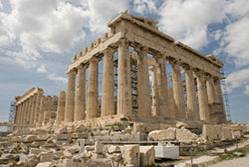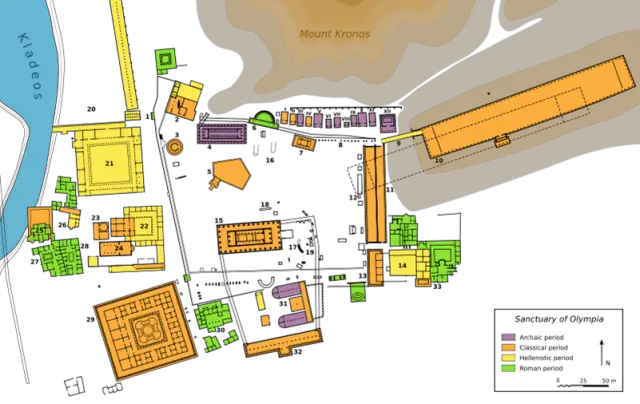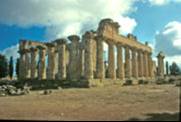The only way to judge of the treasures the Old Masters of whatever age have left us—whether in architecture, sculpture, or painting—with any hope of sound deduction, is to look at the work and ask oneself—”What was that like when it was new?” The Elgin Marbles are allowed by common consent to be the perfection of art. But how much of our feeling of reverence is inspired by time? Imagine the Parthenon as it must have looked with the frieze of the mighty Phidias fresh from the chisel. Could one behold it in all its pristine beauty and splendor we should see a white marble building, blinding in the dazzling brightness of a southern sun, the figures of the exquisite frieze in all probability painted—there is more than a suspicion of that—and the whole standing out against the intense blue sky; and many of us, I venture to think, would cry at once.
Millais.
Greek architecture
Greek architecture began on the shores of the Aegean Sea around 700 BC.
Most Greek buildings in Early Classical periods were made of wood or mud-brick, thus nothing remains of them except a few ground-plans.
The great works of Greek architecture, such as the Parthenon were produced between 700 BC and 145 BC .
Figures aside are some of the examples of Greek buildings.
![[filefield-description]](https://www.archinomy.com/wp-content/uploads/case-studies/2011/temple-of-hephaistos.jpg)

Temple of Hephaistos, Athens Parthenon
Building typologies
The Greeks built temples, tombs, public meeting places, stadiums, amphitheaters, and many other things.
![[filefield-description]](https://www.archinomy.com/wp-content/uploads/case-studies/2011/temple-of-alphaia.jpg)
![[filefield-description]](https://www.archinomy.com/wp-content/uploads/case-studies/2011/karyatides-statues-of-the-erechthion.jpg)
Temple of Alphaia Karyatides statues of the Erechtheion.
![[filefield-description]](https://www.archinomy.com/wp-content/uploads/case-studies/2011/the-palace-of-knossos.jpg)
![[filefield-description]](https://www.archinomy.com/wp-content/uploads/case-studies/2011/theatre-of-dionysus.jpg)
The Palace of Knossos Theatre of Dionysus
![[filefield-description]](https://www.archinomy.com/wp-content/uploads/case-studies/2011/ancient-greek-tomb.jpg)
![[filefield-description]](https://www.archinomy.com/wp-content/uploads/case-studies/2011/gymnasium-ancient-greek-stadium.jpg)
![[filefield-description]](https://www.archinomy.com/wp-content/uploads/case-studies/2011/the-vaulted-tunnel-leading-into-the-stadium.jpg)
![[filefield-description]](https://www.archinomy.com/wp-content/uploads/case-studies/2011/hellenistic-theatre-at-argos.jpg)
![[filefield-description]](https://www.archinomy.com/wp-content/uploads/case-studies/2011/acropolis-of-athens.jpg)
The Acropolis of Athens is the best known acropolis (high city, The “Sacred Rock”) in the world.
Origin and Style
There were two main styles (or “orders”) of Greek architecture, the Doric and the Ionic. But however, the third( which was used in later stage) known as Corinthian also added to the evolution of the Greek architecture.
![[filefield-description]](https://www.archinomy.com/wp-content/uploads/case-studies/2011/origin-and-style.jpg)
| The Doric order was the oldest and simplest of the Greek orders.
It was first used when the Dorians came to Greece. Parthenon is a best example of the Doric order. It is a temple of the Greek goddess Athena, built in the 5th century BC on the Athenian Acropolis. Its decorative sculptures are one of the high points of Greek art. Today it is considered as one of the |
|
| The next major order was the Ionic order.
It was first used around 500 BC and was fancier than the Doric. The pillars were more slender and at the top of the column there were scroll-like ornaments with spirals on either side. Nothing remains of the temple, which was one of the Seven Wonders of the Ancient World. |
|
| The third and the least used order was the Corinthian order.
It began around the same time as the Ionic. Examples of the Corinthian order can be found in Athens. The oldest known example of a Corinthian column is in the Hellenistic Temple of Olympian Zeus, Athens.
|
|
Temples of Greece.
Greek temples were structures built to house the cult statues within Greek sanctuaries. They are the most important and most widespread building type in Greek architecture.
Greeks developed the temple from the small mud-brick structures into a monumental double porticos of the 6th century.
They relied on the regionally specific architectural order for the execution.
Temples were not only build for religious purposes.
They were used as treasuries, and also sometimes as a record office for example registering the names of all public debtors (the expression of “registered upon the Acropolis” eggegrammenoi en Akropoli for example means a public debtor).
The design of Temples depends on symmetry, the rules of which Architects should be most careful to observe.
Symmetry arises from proportion, which the Greeks call analogia.
Proportion is a due adjustment of the size of the different parts to each other and to the whole; on this proper adjustment symmetry depends. Hence no building can be said to be well designed which wants symmetry and proportion.
In truth they are as necessary to the beauty of a building as to that of a well formed human figure- Vitruvius.
![[filefield-description]](https://www.archinomy.com/wp-content/uploads/case-studies/2011/sketch.jpg)
Pronaos: The entrance-hall (porch) to the temple proper.
Naos (Cella in Roman ): the larger of the interior rooms, housed the cult statue.
Opisthodomos. Porch at the rear of the Naos, sometimes also a back entrance.
Adyton: Used as a treasury, a place limited to priest or priestesses.
Stereobate: The foundation of the temple, the upper part of which as a platform or foundation of the row of columns is called the Stylobate
| A distyle Temple “distyle in antis” .
From di (two), stylos (column) and antis the region defined by the two forward extensions of the sidewalls (Antae) of the Naos. |
![[filefield-description]](https://www.archinomy.com/wp-content/uploads/case-studies/2011/visions-of-temple-1.jpg) |
| Other versions tetrastyle in antis for the case of 4 columns between the antae. | ![[filefield-description]](https://www.archinomy.com/wp-content/uploads/case-studies/2011/visions-of-temple-2.jpg)
|
| A prostyle Temple:
A with a colonnaded porch in front of the cella. A amphiprostyle Temple (amphi ,”both sides”) in case of another colonnaded porch in the rear side. |
![[filefield-description]](https://www.archinomy.com/wp-content/uploads/case-studies/2011/visions-of-temple-4.jpg) |
| Peripteral
Temple version (Naos surrounded from all sides by a row of columns) (example: Parthenon), or by a double row of columns (dipteral version) (example: Artemis Temple at Ephesus) Older Temples also had an internal row of columns (colonnade) |
![[filefield-description]](https://www.archinomy.com/wp-content/uploads/case-studies/2011/visions-of-temple-5.png) |
According to the number of columns in the front side:
It can be classified as Tetrastyle, Hexastyle, Octastyle, Dekastyle for 4, 6, 8 or 10 columns respectively.
Example: The Parthenon, a Octastyle Peripteral version,
The Artemis Temple of Ephesus (Dekastyle) is an unusual version the Enneastyle “Basilica”
Templeof Paestum/Poseidonia (9 columns)
Other Temple versions: Tholos, a temple with a circular ground plan.
![[filefield-description]](https://www.archinomy.com/wp-content/uploads/case-studies/2011/the-tholos-at-the-sanctuary-of-athena-pronaia.png)
The Tholos at the Sanctuary of Athena Pronaia
Olympia
Olympia (Greek: Olimpia, Olimbia)
Is a sanctuary of ancient Greece in Elis, is known for having been the site of the Olympic Games in classical times, comparable in importance to the Pythian Games held in Delphi. Both games were held every Olympiad (i.e. every four years), the Olympic Games dating back possibly further than 776 BC.
![[filefield-description]](https://www.archinomy.com/wp-content/uploads/case-studies/2011/olympia.jpg)
The sanctuary, ( Altis) consists of an unordered arrangement of various buildings. Enclosed within the temenos (sacred enclosure) are the Temple of Hera (or Heraion/Heraeum) and Temple of Zeus, the Pelopion and the area of the altar, where the sacrifices were made. The hippodrome and later stadium were built to the east.
To the north of the sanctuary can be found the Prytaneion and the Philippeion, as well as the array of treasuries representing the various city states. The Metroon lies to the south of these treasuries, with the Echo Stoa to the East. To the south of the sanctuary is the South Stoa and the Bouleuterion, whereas the West side houses the Palaestra, the workshop of Pheidias, the Gymnasion and the Leonidaion.
Plan Olympia sanctuary
 |
| 1: North-East propylon – 2: Prytaneion – 3: Philippeion – 4: Temple of Hera – 5: Pelopion – 6: Nymhi of Herodes Atticus – 7: Metroon – 8: Zanes – 9: Crypt (arched way to the stadium) – 10: Stadium – 11: Echo stoa – 12: Building of Ptolemy II and Arsinoe – 13: Hestia stoa – 14: Hellenistic building – 15: Temple of Zeus – 16: Altar of Zeus – 17: Ex-voto of Achaeans – 18: Ex-voto of Mikythos – 19: Nike of Paionios – 20: Gymnasion – 21: Palaestra – 22: Theokoleon – 23: Heroon – 24: Phidias’ workshop and paleochristian basilica – 25: Baths of Kladeos – 26: Greek baths – 27 and 28: Hostels – 29: Leonidaion – 30: South baths – 31: Bouleuterion – 32: South stoa – 33: Villa of Nero Treasuries. I: Sicyon – II: Syracuse – III: Epidamnus ? – IV: Byzantium ? – V: Sybaris ? – VI: Cyrene ? – VII: Unindentified – VIII: Altar ? – IX: Selinunte – X: Metapontum – XI: Megara – XII: Gela |
Olympia is also known for the gigantic ivory and gold statue of Zeus that used to stand there, sculpted by Pheidias, which was named one of the Seven Wonders of the Ancient World by Antipater of Sidon. Very close to the Temple of Zeus which housed this statue, the studio of Pheidias was excavated in the 1950s. Evidence found there, such as sculptor’s tools, corroborates this opinion. The ancient ruins sit north of the Alfeios River and Mount Kronos (named after the Greek deity Kronos). The Kladeos, a tributary of the Alfeios, flows around the area. Its located in the part of Greece which is called Peloponesse
Apollo Temple
![[filefield-description]](https://www.archinomy.com/wp-content/uploads/case-studies/2011/apollo-temple-didyma.png)
Apollo Temple in Didyma, the size of various elements are expressed by ratios of integer numbers from Platonic Pythagorean ideas
![[filefield-description]](https://www.archinomy.com/wp-content/uploads/case-studies/2011/temple-of-concordia-at-agrigentum.jpg)
Temple of Concordia at Agrigentum. |
![[filefield-description]](https://www.archinomy.com/wp-content/uploads/case-studies/2011/temple-of-aphaia.jpg)
Temple of Aphaia (Aegina): |
![[filefield-description]](https://www.archinomy.com/wp-content/uploads/case-studies/2011/temple-of-zeus.jpg)
Temple of Zeus, in Olympia |
![[filefield-description]](https://www.archinomy.com/wp-content/uploads/case-studies/2011/temple-of-apollo-at-paestum.jpg)
Temple of Apollo at Paestum. |
![[filefield-description]](https://www.archinomy.com/wp-content/uploads/case-studies/2011/temple-of-apollo-at-corinth.jpg)
Temple of Apollo at Corinth. |

The temple of Zeus in Cyrene |
There are many architectural monuments and standing towers to which Greeks of ancient times are praised even to this day for their great pieces which looks more as impossible without all the technologies and machines.
Greek architecture is still prominent and can be seen influential in today’s modern building in Europe. They have produced many master-pieces which are still praised as a wonder.

![[filefield-description]](https://www.archinomy.com/wp-content/uploads/case-studies/2011/doric.jpg)
![[filefield-description]](https://www.archinomy.com/wp-content/uploads/case-studies/2011/parthenon-2.jpg)
![[filefield-description]](https://www.archinomy.com/wp-content/uploads/case-studies/2011/lonic.jpg)
![[filefield-description]](https://www.archinomy.com/wp-content/uploads/case-studies/2011/temple-of-artemis.jpg)
![[filefield-description]](https://www.archinomy.com/wp-content/uploads/case-studies/2011/corinthian.jpg)
![[filefield-description]](https://www.archinomy.com/wp-content/uploads/case-studies/2011/athens.jpg)
![[filefield-description]](https://www.archinomy.com/wp-content/uploads/case-studies/2011/visions-of-temple-3.jpg)
Leave a Reply
You must be logged in to post a comment.